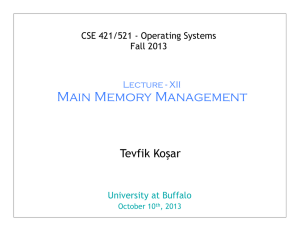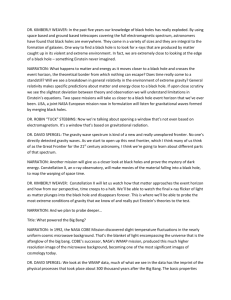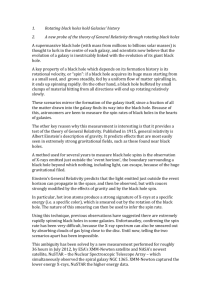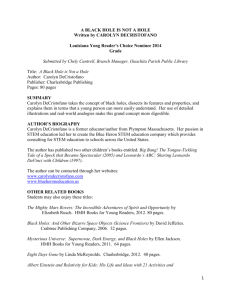July 11 - Memory Management (dynamic partitions, paging intro)
advertisement
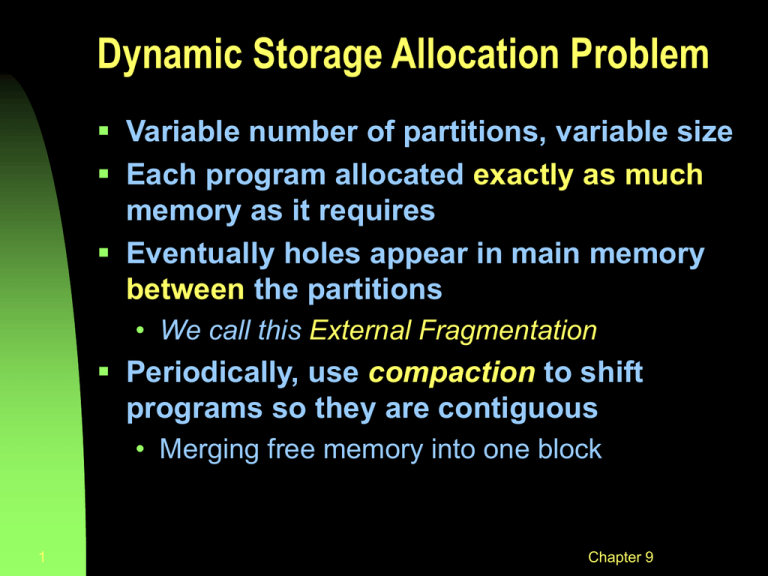
Dynamic Storage Allocation Problem Variable number of partitions, variable size Each program allocated exactly as much memory as it requires Eventually holes appear in main memory between the partitions • We call this External Fragmentation Periodically, use compaction to shift programs so they are contiguous • Merging free memory into one block 1 Chapter 9 Dynamic Storage-Allocation OS keeps a table indicating which parts of memory are available and which are occupied. • Initially all memory is available for user processes (set of holes contains 1 large hole) • When processes arrive and need memory, search for a hole big enough • If a hole is too large, split in 2 (1 part for process, 1 part returned to set of holes) • If new hole is adjacent to other holes, may be merged to form 1 larger hole 2 Chapter 9 Dynamic Partitioning: an example (a-d) P1, P2, P3 are allocated memory. P4 needs 128k: but after loading first 3, there is only a single hole of 64k, so P4 must wait. Eventually all 3 processes are blocked OS swaps out P2 (closest fit) and brings in P4 (128k) 3 Chapter 9 Dynamic Partitioning: an example 4 (e,f) remove process 2, load process 4 leaves a hole of 224128=96K (external fragmentation) (g,h) Process 1 suspended to bring in process 2 again, creating another hole of 320-224=96K... Left with 3 small and probably useless holes. Compaction would produce a single hole of 96+96+64=256K Chapter 9 Placement Algorithm Decide which free block to allocate to a program Possible algorithms: • Best-fit: choose smallest hole that fits creates small holes! • First-fit: choose first hole from beginning that fits generally superior Next-fit: variation: first hole from last placement that fits • Worst-fit: use largest hole leaves largest leftover (also worst fit) Advantages/Disadvantages of Placement Algorithms First fit and best fit are generally better than worst fit • Both are better in terms of storage • First fit is faster than both best and worst fit All suffer from external fragmentation • Exists enough total memory exists to satisfy a request, but it is not contiguous (lots of small holes) • Worst case can have small block of memory between every 2 processes 6 Chapter 9 Compaction External fragmentation can be resolved through compaction Shuffles the memory contents to put all free memory together in one block Compaction algorithm is expensive, but so is not making efficient use of memory, especially with a lot of concurrent processes Only possible if relocation is dynamic • Relocation requires moving program and data, changing the base register 7 Chapter 9 Relocation Because of swapping and compaction, a process may occupy different main memory locations during its lifetime So we usually use special hardware to perform address mapping to allow us to support relocation at run time We will distinguish between logical address and physical address: 8 Chapter 9 Address Terminology Physical address: a physical location in main memory, from the point of view of the memory system. Logical (virtual) address: an address as used in a program, an address as generated by the CPU when executing that program • so an address from point of view of the CPU 9 Chapter 9 Memory Management Unit (MMU) relocation register (base reg) 14000 CPU logical address 123 physical address 14123 memory + MMU • 32 bit address register = 4 Gigabytes of virtual 10 memory • Actually only 64 (128..) Megabytes of physical memory • Need to map down from a large virtual address space to a smaller physical memory space Chapter 9 Paging Fragmentation is a significant problem with all these memory management schemes Let’s organize physical address spaced (main memory) into equal (small) sized chunks called frames. And divide logical (virtual) address space into chunks of the same size called pages The pages of a program can thus be mapped to the available frames in main memory, not necessarily contiguous Result: a process can be scattered all over the physical memory. 11 Chapter 9 Example of Program Loading by Page ..now suppose that process B is swapped out 12 Chapter 9 Process Loading by Page Now process D consisting of 5 pages is loaded Program D does not occupy a contiguous section of memory No external fragmentation! Internal fragmentation limited to part of the last page of each program (average 1/2 page/program). 13 Chapter 9 Page Tables • We keep a page table for each process • A page table entry is the frame number where the corresponding page is physically located • Page table is indexed by page number to obtain the frame number • We also need a Free frame list to keep track of unused frames Logical Address in Paging Within each program, each logical address consists of a page number and an offset within the page A Memory Management Unit (MMU) is put between the CPU address bus and physical memory bus A MMU register holds the starting physical address of the page table of the process currently running Presented with a logical address (page number, offset) the MMU accesses the page table to obtain the physical address (frame number, offset) 15 Chapter 9

